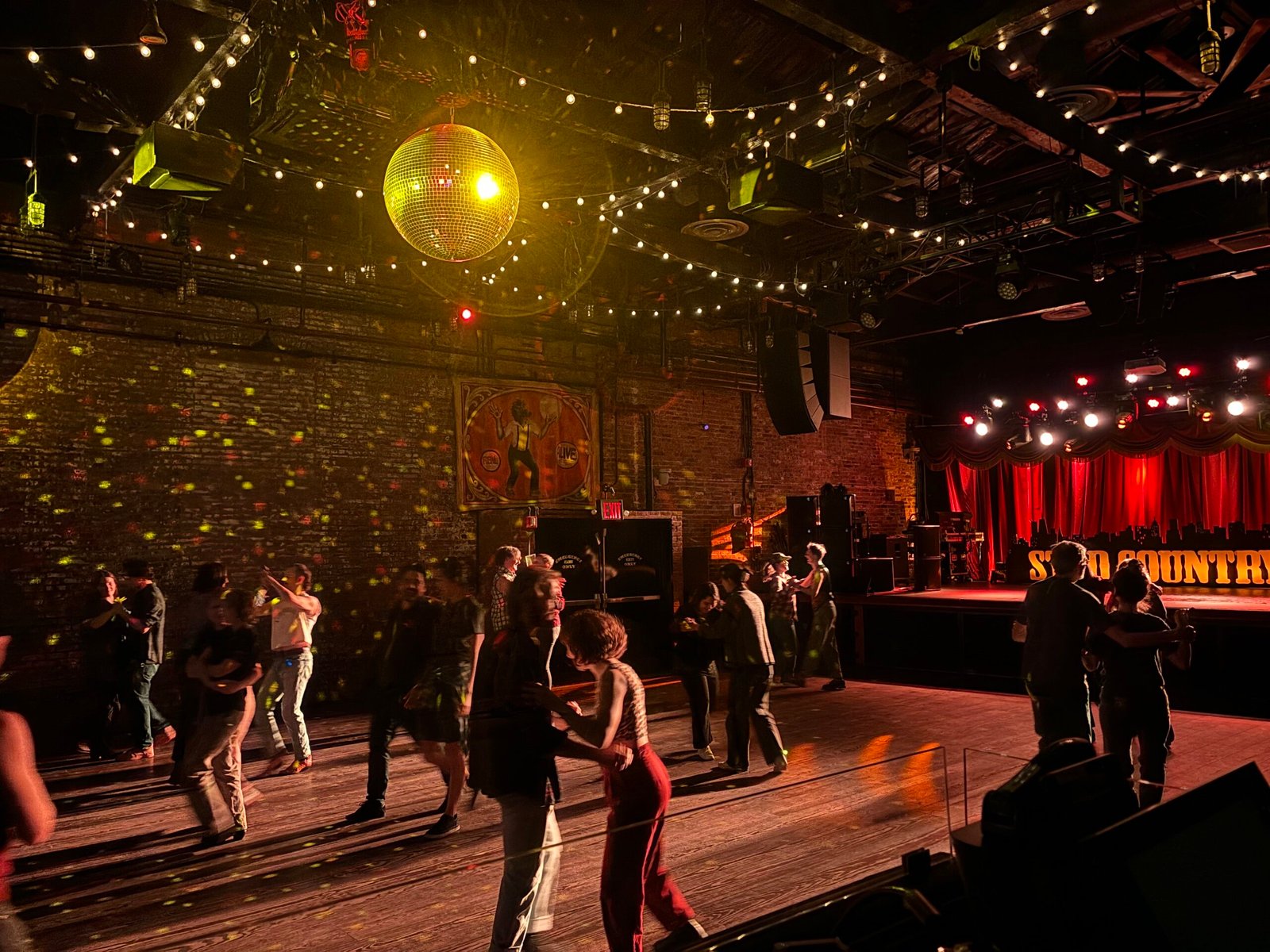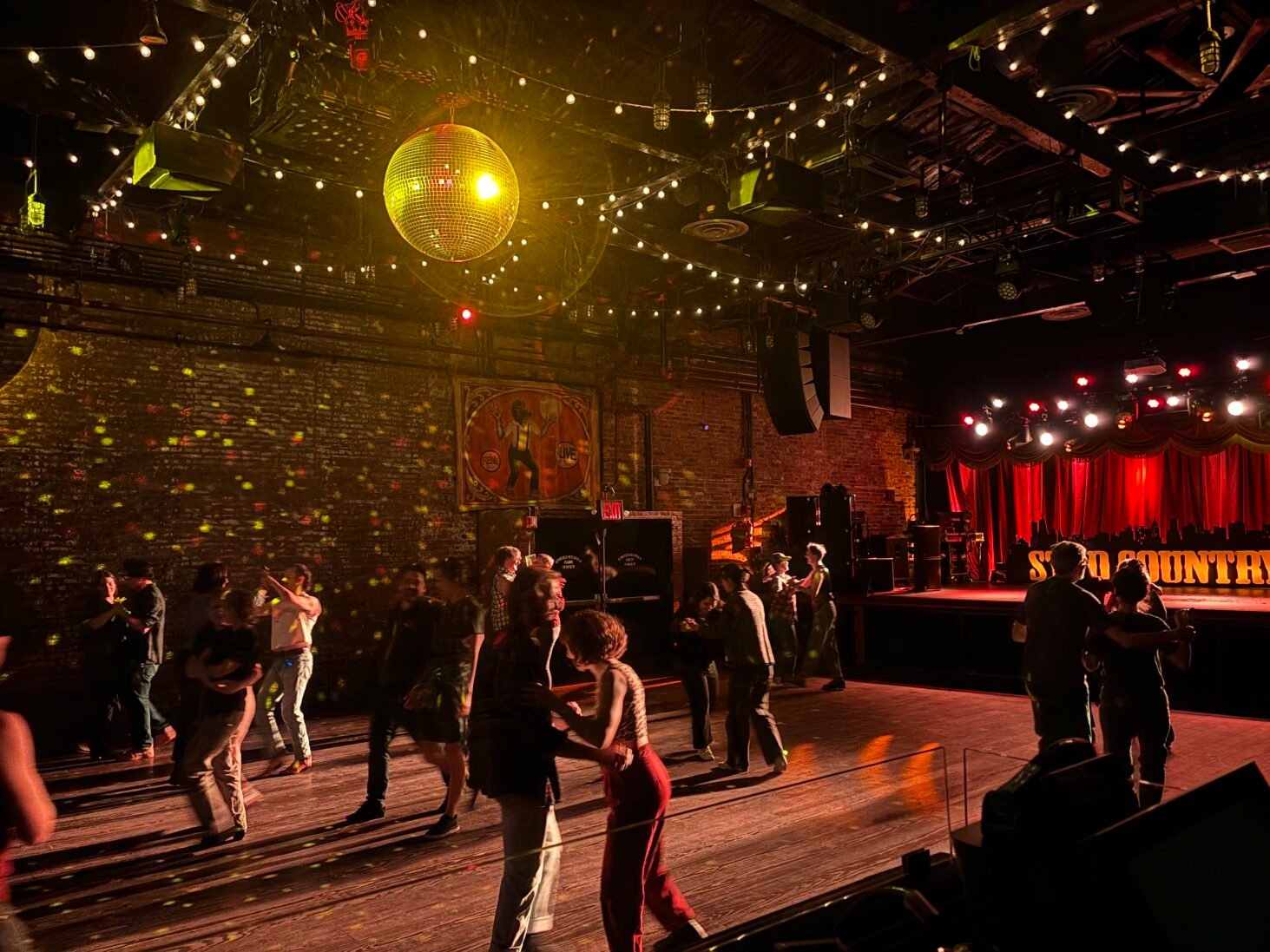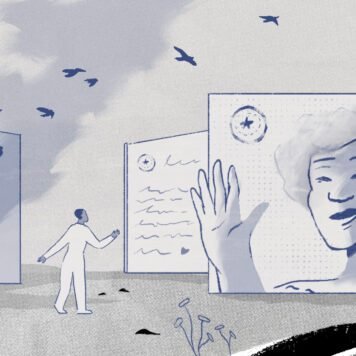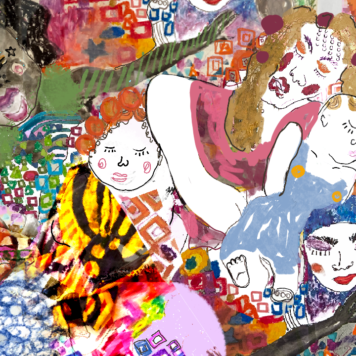It’s a weeknight in New York City. The cowboys, cowgirls, and cowpokes are making their way down the subway platforms, boots knocking, bandanas ruffling in the wind, to dance.
Whether in a restaurant backroom, a studio in the Garment District, a warehouse in Ridgewood, or a bowling hall in Brooklyn, outposts of western country dancing have cropped up in pockets of the Big Apple. Here, people two-step, waltz, swing and line dance to the early hours of the night, swaying around partners and dropping it low to songs from “Heads Carolina, Tails California” to “Red Wine Supernova.” Disco balls and mood lighting fleck sparks over couples of all combinations, twirling in a loose circle on the floor – a galaxy of sweat, sequins, and denim.
It might be surprising to find such a rich scene for country dancing in New York. Even more: that it’s overall host to queer people who find it supremely cool.
The queer church of country dance
Part of this sudden influx of openly queer country dance spaces is due to the rise of Stud Country, a country dancing organisation which launched two years ago in LA. First taking up residence in Club Bahia, a dance hall on Sunset Boulevard, the founders Sean Monaghan and Bailey Salsbury sought to create a new space for queer two-steppers and line dancers after the pandemic-era closure of Oil Can Harry’s, a historic gay western bar and dance floor in Studio City.
Chronicled in a recently released short film by the LA Times, Stud Country began as a place for Oil Can Harry’s old regulars to keep dancing, but also ended up attracting a younger, wider crowd of queer Angelenos interested in the practice. Now, it’s no longer so much a word-of-mouth hideaway, but a phenomenon – a “Queer Church of Country Dance” – that has spread to San Francisco, Nashville, and New York City, even throwing parties with Lincoln Center and Kesha.
Personally, I walked into my first line dance class – not at Stud – in sneakers and jeans about a year and a half ago. Over that period, I have seen the dance floor get more and more crowded with newbies, old hands, and everyone in between who has been bitten by the country bug. In the middle of a hectic and demanding modern life, traditional forms of dancing have become a haven for reconnecting with our own bodies, and reconnecting with others.
At one of their November parties, Jolie, who was managing the check-in desk at the Brooklyn Bowl, told me: “I have a background in ballet, and going line dancing is how I’ve fallen back in love with dancing. Especially since there are steps and choreography that people can follow, it’s maybe more approachable for people.”
Their friend, Sam, chimed in: “People come to see and to be seen. There’s a lot of power and community in doing something in unison.”
Maya, another Stud Country attendee, described it as an “ecstatic ritual.” It’s not hard to see how, when you witness a whirl of dancers break out into stomping, clapping, spinning choreography – or when you find yourself in the same crush, moving as others move, feeling like you’re part of the same resonating structure.

A history of transgressive touch
Sean and Bailey, Stud Country’s founders, have always been clear about the group being a way to pay tribute to a queer country dance history that has long predated the scene as we witness it now – a history that many of Stud’s attendees aren’t wholly familiar with.
Before the Chappell Roan bandanas and the choreography to “Guess” by Charli XCX, and the general adoption of country dance by the bicoastal urban gay scene, country dancing in same-sex spaces was thriving, radical, and taboo.
In an interview, Dr. Kathryn Alexander, an ethnomusicology professor at the University of Arizona who has spent eight years studying the landscape of queer American country dancing practices and spaces, estimates that country dancing “pops” about every decade. And perhaps we were overdue: the last big wave of interest crested around the 90s and early 2000s, with Billy Ray Cyrus’ hit music video for “Achy Breaky Heart” and the film Brokeback Mountain (2004) driving both straight and gay people to the dancefloor.
But while country dance practices have been around for years – she notes that they have even been practiced on the frontier in same-sex combinations, though not with a homosexual intention – she pinpoints the rise of queer country dancing culture in the 1970s.
“We are in a moment when America is getting into country again,” she says. “It poses a real difference, but also a connection to disco, which was the big dance craze of the 70s, which emerged in queer communities of colour in cities like New York, among others. Disco involved line dancing, as well as couples and partner dancing, and because country western dancing offers the same kinds of dance formats, there’s a kind of legibility between them.”
But country dancing presented a different type of queer dance culture compared to disco. Country was literally and metaphorically more buttoned-up. Dr. Alexander notes that rules of etiquette inherent in country spaces and in the dance form seemed to discourage the hedonism of disco, from banning drinks on the dance floor to following partner dance instructions that allow for closeness without sexual touching. Twirling around the floor to a Merle Haggard song, chest to chest, was very different from Saturday Night Fever.
Susanna Stein, of Big Apple Ranch, agrees. “I think it’s a nice alternative to the bar scene, which used to be the only way to meet people before social media,” she says in an interview. “It’s not about drinking. It’s not about picking somebody up. That might happen, but it’s a really different vibe from the bar.”
In 1996, Susanna helped found Big Apple Ranch, one of the last surviving queer country dancing associations in New York City from the previous millennium.
Gay western bars opened up a world alongside disco where same-sex physical touch was not overtly sexual. It cultivated a closeness and intimacy that still draws people into the practice today. And this closeness, even with only undercurrents of sexual attraction and flirtation, was still radical for the time.
“While we feel in this era that it’s a little unremarkable to be able to touch someone of the same gender when you are attracted to them, in the 70s that was pretty transgressive and still really hard to do especially in public spaces, especially on dance floors,” shares Dr. Alexander. “So country western dancing – two-step, waltz, and western swing – allowed people to actually touch each other and dance together and I think that kind of intimacy was really important for a lot of the queer folks who came out in the 70s.”
Subscribe to shado's weekly newsletter
Exclusive event news, job and creative opportunities, first access to tickets and – just in case you missed them – our picks of the week, from inside shado and out.

There’s an element of vulnerability when you put yourself out there and dance with another person. Both Susanna and Dr. Alexander spoke to the appeal of partner dancing, where you put three minutes of your time and movement in the hands of another dancer. Susanna described it as “safety.” Dr. Alexander described it as “trust.”
That safety and trust with a partner and within a community has a whole new dimension after the COVID-19 pandemic, where partner dancing was impossible under social distancing rules and many mainstays of the gay western scene closed down. Poignantly, for queer country dancers, it had echoes of the AIDS epidemic of the early 1980s, where touch and proximity was fraught with worry. Now, I feel that some of the burning hot popularity of Stud Country stems from this desire to be close with each other after years of isolation.
Queer country now: sexy, cool… mainstream?
This vision of country dancing – radically genteel and “politely different” – is still championed by dozens of organisations and bars spanning the country today. Groups like the International Association of Gay/Lesbian Country Western Dance Clubs, or the IAGLCWDC (“Iggle-Wiggle,” as Susanna calls it), host yearly competition hoedowns and gatherings. Founded in 1991, their photos are still dominated by older members in hats, boots, plaid, and blue jeans, wearing competitor’s pennants and carrying team banners.
But while these echoes of culture persisted past the craze, Stud Country is a different breed. Across Instagram, they post sweaty flash photos of their weekly parties, classes, and partnerships (again – Kesha) to an audience of 36.4k followers. Their repertoire has built on the “critical mass” of 90s country music – Shania Twain, Billy Ray Cyrus, Reba – to include Charli XCX, Troye Sivan, and Kylie Minogue. Most recently, they provided the backdrop and choreography to “Sugar in the Tank,” the newest collaboration between indie rocker Torres and Julien Baker of gay supergroup fame. As Susanna says, Stud Country made country dancing seem “kind of sexy and cool.”
Some of Stud Country’s parties seem worlds away from past versions of the culture. Post-gay marriage, and as queer culture is assimilated into the mainstream, their current vision of country-queer expression is very different from how country dance was first queered in the 20th century.
2024’s Goth Ball suggested attire included “Dead cowboy. Heavy eyeliner and leather. Emo mall rat. Victorian ghost in a powdered wig. Evil fae and sprites. Your glamorous self (ah!)” Attendees showed up to dance in everything from vampire costumes to fetishwear, bringing a Berghain sensibility to the dance hall. In the recent evening I attended, I saw drag Dorothy busting it down in her ruby red slippers, alongside people adding bumps, grinds, and sloppy makeouts to their choreo. On other parts of the floor, there are even groups of straight-presenting couples and dancers, some seemingly very surprised at stumbling into a scene so unapologetically queer.
Stud Country may have revived the thrill of country dancing for a new generation, but what do we gain and lose with this new, seismic change in the culture?
It’s part of a larger question facing the queer community as queer spaces change. As the world becomes more accepting of queerness, queer-only spaces lose their secrecy and their historically protective status. In many ways that’s a joyous thing. In many other ways, it evokes thornier questions about where to draw the line. Is it okay for straight bachelorette parties to go to gay bars? Should you bring your boyfriend to Cubbyhole?
On the other hand, if we ditch the hats, the chaps, and at least some of the old-school etiquette and dances, what about this practice continues to feel “country?” For Stud Country at least, many of the attendees are from the same metropolitan queer milieu, far from the culture and roots of cowboys and hoedowns. Some of the impulses of the attendees are learned from touchstones of other gay nightlife, their cowboy boots for dancing and strutting rather than encountering any sort of cattle. Or, is a changing country genre with artists like Beyoncé and Trixie Mattel also responsible for rubbing away at what country is ‘supposed to be?’
The answers to these questions are not simple – you would get different answers from people across generations, across genders, across urban, rural, and racial divides. But what matters to many is that the tradition and the community are continuing to grow.
“I think, big picture, it’s the great thing about allowing ourselves to be open to cultures that we don’t have a personal connection to,” says Dr. Alexander. “A lot of queer folks think that country is antithetical to our presence and our stories and our lives. To find a way to connect to it and sort of say, well, you know, maybe for some folks it is antithetical, but for me it’s not, that’s valid, because we are still in queer culture and queer community and queer folks are among us. I think that’s a good reminder, especially in an era where our communications and our beliefs are so often siloed – it’s good to allow ourselves to be surprised.”
Being surprised and being proven wrong about yourself and about your expectations is the hook of country dancing. Personally, country dancing was a big experiment to be out and about doing things in places I’ve never felt the most welcome, whether it’s a gay spin on a traditionally conservative genre, attempting dance as a non-dancer, or participating in such an American cultural touchstone as a new American.
I was proven wrong so many times over a year and a half since I started. I’ve grown to love moving around, to begin to reconnect my mind and my body in ways that a computer desk job just doesn’t satisfy. I have become a true convert to the church of country dance. Even my Spotify wrapped was overwhelmingly country this year. Transcending convention and expectation in favour of a full-body embrace of new expressions and experiments has only been a source of joy and empowerment.

“We cleave together when times are tough.”
If the element of surprise is the hook, the community in the country dance scene is the line and sinker. Susanna maintained that the key to Big Apple Ranch and country dancing’s survival is the tireless effort and service of peer-pressurers.
The first time she attended a country dancing event, she was brought by a friend to a gay country western bar called Rawhide in San Francisco.
“It was not something I was at all interested in,” she recalls. “You’re not really gonna see an ad or a poster or whatever and think oh yeah I’m gonna go try that. It requires you to be dragged there by somebody. I didn’t like country music. I didn’t like dancing, but this friend dragged me there and I loved it so I have kept doing it ever since.”
The sense of community among those who stay is palpable and enthralling. Sean notes in the documentary that people started asking, “are we going to church?” in reference to Stud Country’s regular nights at Club Bahia. Spending every week with familiar people, moving alongside each other in unison, encouraging the beginners, respecting the regulars, chatting quietly face-to-face, hands on hips and shoulders, it “gets thick, quick,” said Mackenzie, who brought me and my partner country dancing that one fateful evening a year and a half ago.
“Physical intimacy with a dance partner is something that people return to periodically,” Dr. Alexander notes. “The idea that we cleave together when times are tough. We are perhaps literally doing that on the dance floor.”
And with tougher and ever more divisive times ahead, there may not be a better time to be a little queer country-curious. As a space for queerness and community, for widening the mind and broadening our tastes, and for getting in touch with yourself and with others, Stud Country in 2025 isn’t just kitsch – it’s well within the political, radical, and transgressive history of country dance.
“Keep doing it,” is Susanna’s advice to the next generation of dancers. “Keep carrying the torch. And keep bringing your friends.”
What can you do?
- Watch Stud Country’s mini documentary
- If you are in New York City, San Francisco, Los Angeles, Chicago, or Palm Beach, Stud Country has classes, dance nights, or pop-ups. .
- Iggle-Wiggle, the International Association of Gay/Lesbian Country Western Dance Clubs has chapters in cities across the United States to join, learn, and dance.
- Stud Country is also promoting fundraisers on their Instagram for those affected by the Los Angeles wildfires — donate, come dance, and bring a friend!
- Read: Country is back — is conservatism next?
- If you’re in NYC head to the Big Apple Ranch dance club






